| Conference program |
Reception precedes BoggleTM presentation
in first video |
Welcome Reception
Isaac Kunen |
| |
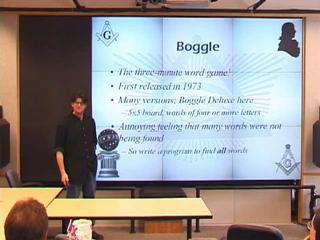 |
A Computer Analysis of BoggleTM
Craig Kaplan
Abstract
Boggle is a fast-paced word search game played on a
five-by-five grid of letters. To remove any trace of fun
from the game, I have conducted an extensive analysis of
Boggle, using a newly-constructed software tool. I
present the tool and the Boggle insights in provides.
|
| |
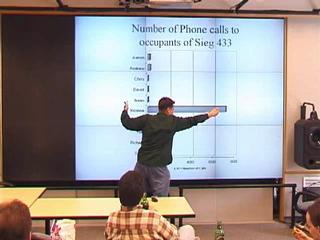 |
On the Number of Phone Calls to Occupants of Sieg 433 Answered by Someone Other than the Recipient Between 18.2.2001
and 14.5.2001
Isaac Kunen, Sorin Lerner, and Andrew Whitaker
(Presented by Sorin Lerner)
Abstract

|
| |
 |
A Measurement Study of Student Space
in Modern Graduate Courses
Stefan Sariou Saroui Saroiu
Abstract
We start by explaining the parallel between monolithic
operating systems and modern day Computer Science
courses. We then define the concepts of professor space
and student space. We present the results and analysis
of a one-hour trace of student space in one of the
University of Washington Computer Science Courses. We
finally conclude that most of the time spent in student
space in a graduate course in due to a few of the
participant students.
|
| |
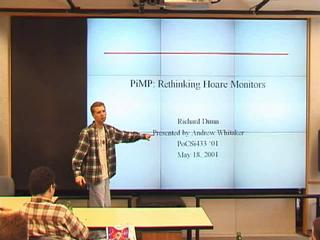 |
PiMP: Rethinking Hoare Monitors
Richard Dunn
(Presented by Andrew Whitaker)
Abstract
We describe the design of PiMP, the Pimpant Management
Protocol, which utilizes Hoare monitors in a novel way
for use in the management and marketing of Hoares. We
describe some preliminary performance results from its
implementation in the hOS operating system and the
128-bit CHES encription system.
|
| |
 |
Beyond Moore's Law
Isaac Kunen
Abstract
Moore's Law is an observation that the number of
transistors in a processor, a rough indicator of the
performance of a chip, has, for some time, doubled
approximately every 18 months. This rule has held true
for over a quarter of a century, but cannot hold true
forever due to the physical limitations of hardware
design. We argue that instead of transistor density or
speed we should be looking at the apparent
speed, how fast a computer appears to the user.
Since the number of transistors is only of tangential
interest to the real goal of increasing the apparent
speed of a computer, we propose several methods in which
this apparent speed can be increased without altering the
underlying hardware. Our novel proposal frees us from
the underlying physical problems inherent in speeding up
hardware, and will let us continue, if not add to, the
rate at which process performance increases.
|
| |
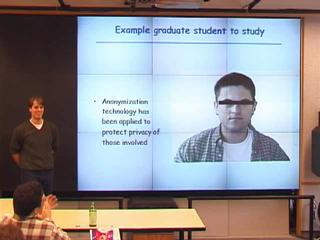 |
Keynote Address
Steve Gribble
Introduced by Andrew Whitaker
|
| |
 |
The Impact of Artificial Engineering
on the Life of Average Americans
Bart Niswonger, Stephanie Smith
(Presented by Bart Niswonger)
Abstract
Once upon a time, there was a mad scientist who invented
what we call today stroganoff. Everyone ate it, thinking
it was food, but little did they know each
"noodle" was a highly advanced life form.
Eventually these "noodles" joined in solidarity
and struck back against the monstrous man -- they tossed
them in with some meatballs, and licked their plates clean.
|
| |
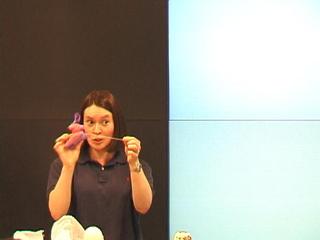 |
Computer Science: Science or Religion?
Sarah Schwarm and Tammy VanDeGrift
(Presented by Tammy VanDeGrift)
Abstract
The role of computer science in the academic world is an
issue of long-standing debate: is computer science a true
science, or is it better classified as a branch of
engineering? The arguments on both sides are numerous,
and prominent academic institutions disagree on this
issue. In this paper, we address another lesser-known
but equally important question: is computer science best
classified as science or religion?
|
| |
 |
Tape cars: An experimental study
Steven A. Wolfman and Rachel A. Pottinger
(Presented by Steven A. Wolfman)
Abstract
After a recent colloquium extolling the virtues of tape
as an interface, the authors decided to pursue an
experimental study of the medium.
|
| |
| No video available |
The Snake: Experience and Research
Ratul Mahajan
Abstract
This paper talks about the author's experiences with the
Snake; how it has fundamentally changed the way he works
and made him more "productive." It gives
insights into how the Snake can be controlled, and how to
score big-time using the Snake. The paper also
formalizes the Snake control theory. It describes
results of a user study, in which users with no prior
Snake experience played with the author's Snake. The
paper ends with a description of the open research issues
concerning the Snake.
|
| |
| No video available |
Awards presentation
Isaac Kunen |


 CSE Home
CSE Home About Us
About Us Search
Search Contact Info
Contact Info 







